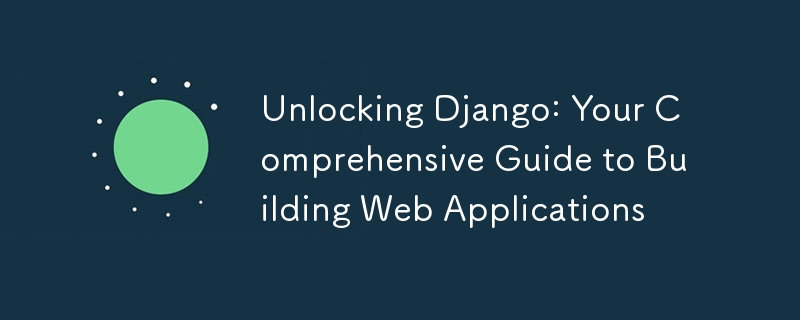
Django Web Framework: A Comprehensive Guide
What is Django?
Django is a high-level Python web framework that enables rapid development of secure and maintainable websites. It is known for its "batteries included" approach, providing many built-in features that make web development efficient.
Key Features of Django
-
Portable and Versatile: Django is written in Python and can run on multiple platforms, including Linux, Windows, and macOS. It is well-supported by many web hosting providers.
-
MVC Pattern: Django follows the Model-View-Controller (MVC) pattern, which separates the logic into models (data structure), views (displaying data), and controllers (handling interactions between models and views).
-
Reusability and Maintainability: Django promotes the Don't Repeat Yourself (DRY) principle, reducing code duplication and encouraging the creation of reusable "applications" and modules.
Setting Up a Django Development Environment
To start with Django, you need to set up a development environment. Here are the steps:
-
Create a Project: Use the command django-admin startproject mysite to create a new Django project. This will generate the basic directory structure and files needed for a Django project.
-
Create an App: Within the project, you can create separate apps using python manage.py startapp appname. Each app handles a self-contained task within the project.
-
Configure Settings: Ensure the app is included in the INSTALLED_APPS list in the project's settings.py file.
Building a Django Application
Here’s a step-by-step guide to building a Django application:
-
Define Models: Models represent the data structures and are defined in models.py. Each model is a Python class that subclasses django.db.models.Model.
from django.db import models
class ModelName(models.Model):
field_name = models.Field(**options)
Copy after login
-
Create Views: Views handle the logic for displaying data and are defined in views.py. They return HttpResponse objects.
from django.http import HttpResponse
def index(request):
return HttpResponse("Hello, world. You're at the polls index.")
Copy after login
-
Define URL Patterns: URL patterns are defined in urls.py and map URLs to views. This is done using the path function from django.urls.
from django.urls import path
from . import views
urlpatterns = [
path("", views.index, name="index"),
]
Copy after login
-
Use the Admin Site: Django provides an admin site for managing data. You can register models with the admin site and use it to add, change, and delete data.
Tutorials and Examples
-
Local Library Website: A comprehensive tutorial on MDN guides you through creating a "Local Library" website, covering topics from setting up the environment to creating models, views, and templates.
-
Poll Application: The official Django documentation provides a tutorial on creating a basic poll application, which includes setting up a project, defining models, views, and URL patterns.
-
Portfolio App: Real Python offers a tutorial on building a portfolio app with Django, covering the architecture of a Django site, setting up multiple apps, and creating models and views.
Additional Resources
-
Django Documentation: The official Django documentation is a rich resource for learning and troubleshooting.
-
MDN Web Docs: MDN provides detailed guides and tutorials on using Django for web development.
Conclusion
Django is a powerful and versatile web framework that simplifies the process of building complex web applications. With its robust set of built-in features, adherence to the MVC pattern, and extensive documentation, Django is an excellent choice for both beginners and experienced developers.
Sources:
- [Django Web Framework - Learn web development | MDN]
- [Writing your first Django app, part 1 | Django Documentation]
- [Python Web Development With Django - GeeksforGeeks]
- [Get Started With Django: Build a Portfolio App - Real Python]
- [Django introduction - Learn web development | MDN]
? This article is part of a weekly newsletter on Topic "Django" powered by SnapNews.
? https://snapnews.me/preview/70528bc0-3600-461f-b833-a8cf8b1102f0
? Want personalized AI-curated news? Join our Discord community and get fresh insights delivered to your inbox!
AINews #SnapNews #StayInformed
The above is the detailed content of Unlocking Django: Your Comprehensive Guide to Building Web Applications. For more information, please follow other related articles on the PHP Chinese website!






